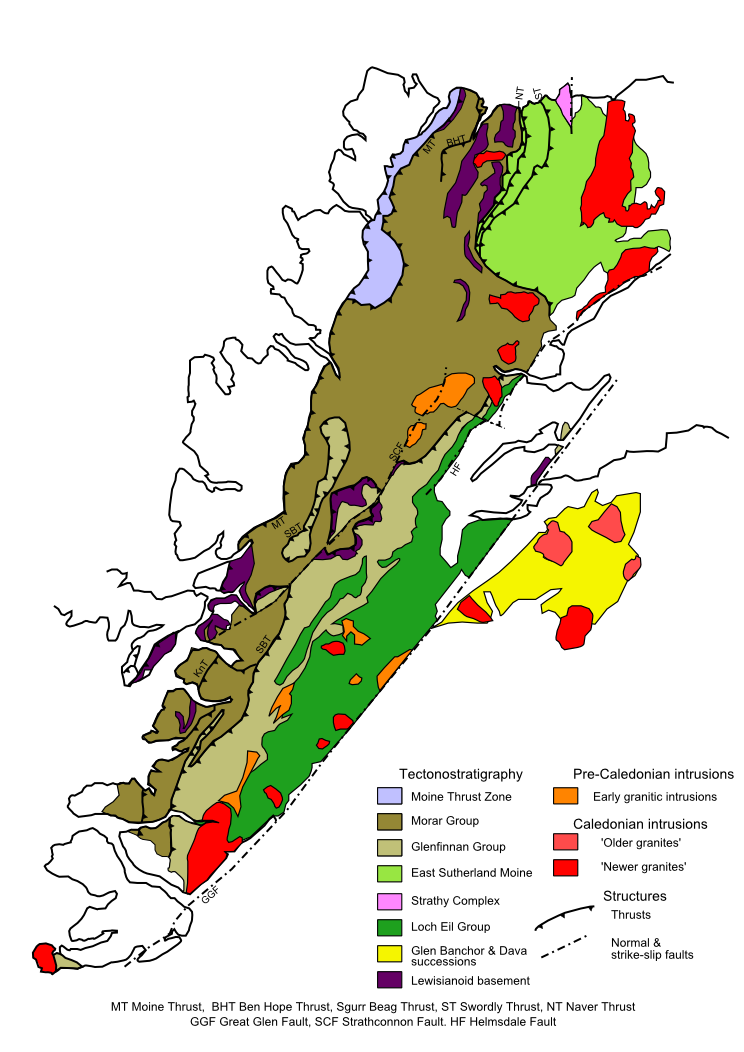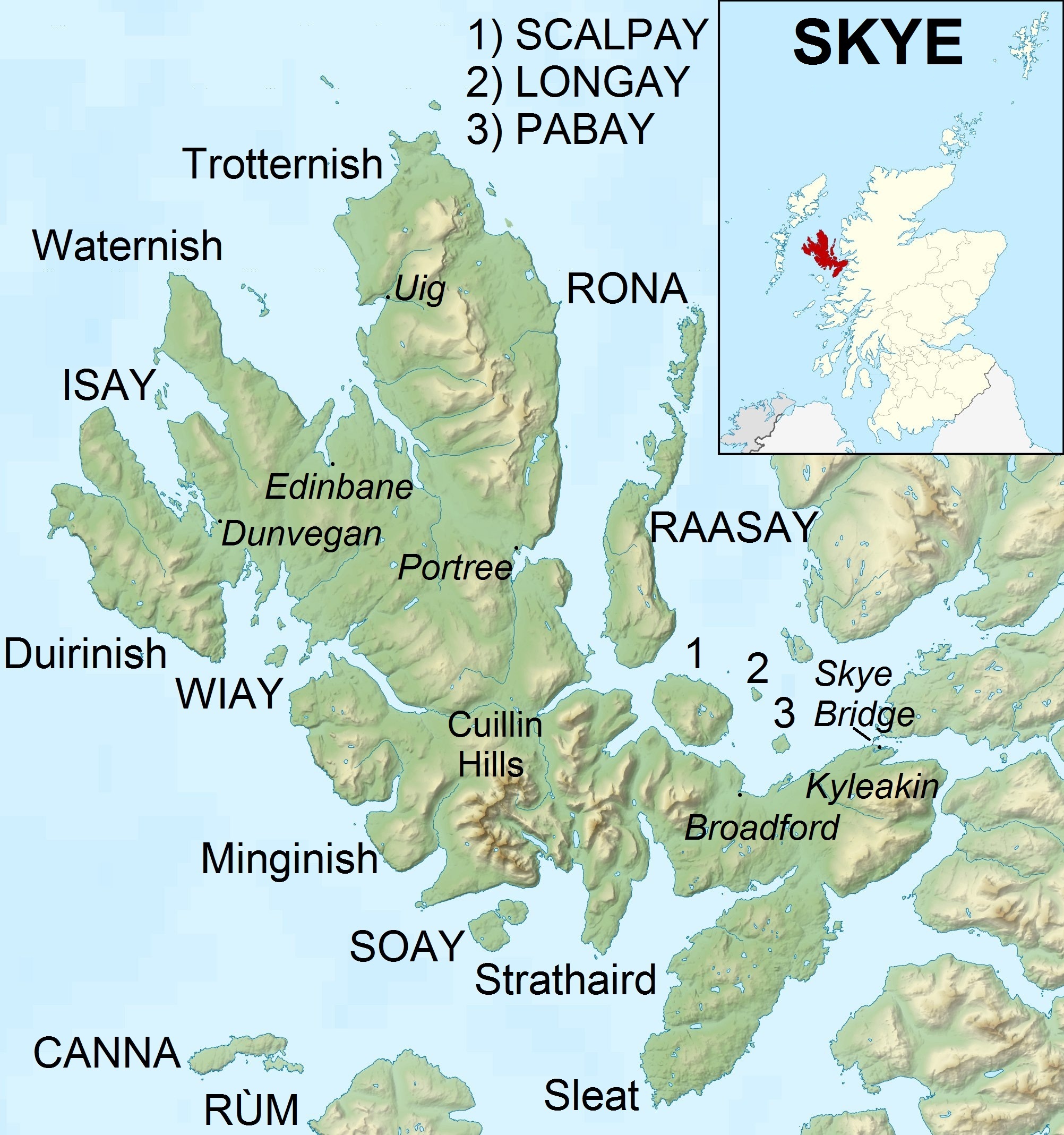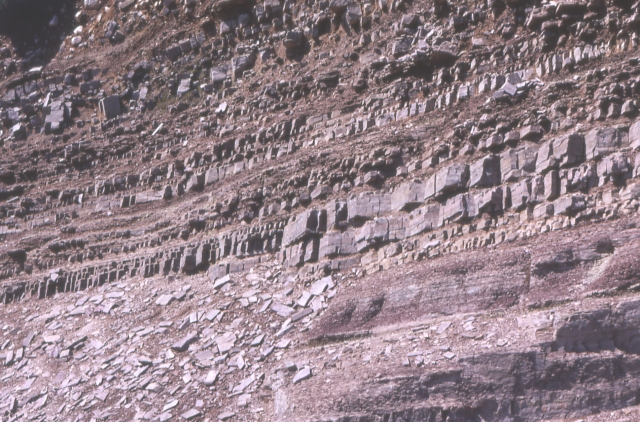|
Northwest Highlands
The Northwest Highlands are located in the northern third of Scotland that is separated from the Grampian Mountains by the Great Glen (Glen More). The region comprises Wester Ross, Assynt, Sutherland and part of Caithness. The Caledonian Canal, which extends from Loch Linnhe in the south-west, via Loch Ness to the Moray Firth in the north-east splits this area from the rest of the country. The city of Inverness and the town of Fort William serve as gateways to the region from the south. Geology The geology of the Highlands is complex. Along the western coastal margin it is characterised by Lewisian gneiss, the oldest rock in Scotland. Liathach, Beinn Alligin, Suilven, Cùl Mòr, Cùl Beag, and Quinag are just some of the impressive rock islands of the significantly younger rich brown-coloured Torridonian sandstone which rests on the gneiss. Some of the peaks, such as Beinn Eighe and Canisp, are topped with later light grey or white Cambrian quartzite. Cambro-Ord ... [...More Info...] [...Related Items...] OR: [Wikipedia] [Google] [Baidu] [Amazon] |
Scotland
Scotland is a Countries of the United Kingdom, country that is part of the United Kingdom. It contains nearly one-third of the United Kingdom's land area, consisting of the northern part of the island of Great Britain and more than 790 adjacent Islands of Scotland, islands, principally in the archipelagos of the Hebrides and the Northern Isles. To the south-east, Scotland has its Anglo-Scottish border, only land border, which is long and shared with England; the country is surrounded by the Atlantic Ocean to the north and west, the North Sea to the north-east and east, and the Irish Sea to the south. The population in 2022 was 5,439,842. Edinburgh is the capital and Glasgow is the most populous of the cities of Scotland. The Kingdom of Scotland emerged as an independent sovereign state in the 9th century. In 1603, James VI succeeded to the thrones of Kingdom of England, England and Kingdom of Ireland, Ireland, forming a personal union of the Union of the Crowns, three kingdo ... [...More Info...] [...Related Items...] OR: [Wikipedia] [Google] [Baidu] [Amazon] |
Beinn Alligin
Beinn Alligin () is one of the classic mountains of the Torridon region of Scotland, lying to the north of Loch Torridon, in the Highlands. The name Beinn Alligin is from the Scottish Gaelic, meaning ''Jewelled Hill''. The mountain has two peaks of Munro status: Tom na Gruagaich () to the south, and Sgùrr Mhòr at to the north. One of the most prominent features of Beinn Alligin is a great cleft known as Eag Dhubh na h-Eigheachd (''black gash of the wailing'') or Leum na Caillich, which cuts into the ridge south of the summit. It is the scar of the most spectacular rockslide or rock avalanche in Britain, which runs out into the corrie of Toll a' Mhadaidh Mor. It occurred around 3750 years ago and is around 3.5 million cubic metres in volume. According to local folklore shepherds on the mountain would hear cries from the gash; those who investigated the source of these cries would inevitably fall to their deaths. Beinn Alligin lies on the National Trust for Scotland's To ... [...More Info...] [...Related Items...] OR: [Wikipedia] [Google] [Baidu] [Amazon] |
Moine Supergroup
The Moinian or just the Moine, formerly the Moine Supergroup, is a sequence of Neoproterozoic metasediments that outcrop in the Northwest Highlands of Scotland between the Moine Thrust Belt to the northwest and the Great Glen Fault to the southeast and one part of the Grampian Highlands to the southeast of the fault. It takes its name from ''A' Mhòine'', a peat bog in northern Sutherland. History of research The metamorphic rocks that are now known informally as "the Moine" were originally interpreted as of Silurian age, as they lie in sequence with Cambrian to lower Silurian sedimentary rocks (now known to be lower Ordovician at the youngest and part of the Ardvreck Group). This view, espoused particularly by Roderick Murchison, a geologist known as the "Master of the Silurian", was opposed by James Nicol, who thought that the contact (or "zone of complication" as he called it) was tectonic in nature and that the metamorphic rocks were older and not in stratigraphic ... [...More Info...] [...Related Items...] OR: [Wikipedia] [Google] [Baidu] [Amazon] |
Skye
The Isle of Skye, or simply Skye, is the largest and northernmost of the major islands in the Inner Hebrides of Scotland. The island's peninsulas radiate from a mountainous hub dominated by the Cuillin, the rocky slopes of which provide some of the most dramatic mountain scenery in the country. Slesser (1981) p. 19. Although has been suggested to describe a winged shape, no definitive agreement exists as to the name's origin."Gaelic Culture" . VisitScotland. Retrieved 5 January 2013. The island has been occupied since the period, and over its history has been occupied at various times by Celtic tribes includ ... [...More Info...] [...Related Items...] OR: [Wikipedia] [Google] [Baidu] [Amazon] |
Durness
Durness () is a village and civil parish in the north-west Highlands of Scotland. It lies on the north coast of the country in the traditional county of Sutherland, around north of Inverness. The area is remote, and the parish is huge and sparsely populated, covering an area from east of Loch Eriboll to Cape Wrath, the most north-westerly point of the Scottish mainland. The population is dispersed and includes a number of townships including Kempie, Eriboll, Laid, , Sangobeg, Leirinmore, Smoo, Sangomore, Durine, Balnakeil and Keoldale. Etymology The name could be Norse "Dyrnes", meaning "deer/animal headland". No one knows for sure where the name derives; it has variously been translated as from "Dorainn nis" tempest point, or "Dhu thir nis" the point of the black land; or from the Norse for deerpoint. Or even from the main village "Durine" which would translate as "Dubh Rinn" the black (or fertile) promontory, with the Norse "ness" tacked onto an existing Gaelic name. ... [...More Info...] [...Related Items...] OR: [Wikipedia] [Google] [Baidu] [Amazon] |
Limestone
Limestone is a type of carbonate rock, carbonate sedimentary rock which is the main source of the material Lime (material), lime. It is composed mostly of the minerals calcite and aragonite, which are different Polymorphism (materials science), crystal forms of calcium carbonate . Limestone forms when these minerals Precipitation (chemistry), precipitate out of water containing dissolved calcium. This can take place through both biological and nonbiological processes, though biological processes, such as the accumulation of corals and shells in the sea, have likely been more important for the last 540 million years. Limestone often contains fossils which provide scientists with information on ancient environments and on the evolution of life. About 20% to 25% of sedimentary rock is carbonate rock, and most of this is limestone. The remaining carbonate rock is mostly Dolomite (rock), dolomite, a closely related rock, which contains a high percentage of the mineral Dolomite (mine ... [...More Info...] [...Related Items...] OR: [Wikipedia] [Google] [Baidu] [Amazon] |
Ordovician
The Ordovician ( ) is a geologic period and System (geology), system, the second of six periods of the Paleozoic Era (geology), Era, and the second of twelve periods of the Phanerozoic Eon (geology), Eon. The Ordovician spans 41.6 million years from the end of the Cambrian Period Megaannum, Ma (million years ago) to the start of the Silurian Period Ma. The Ordovician, named after the Celtic Britons, Welsh tribe of the Ordovices, was defined by Charles Lapworth in 1879 to resolve a dispute between followers of Adam Sedgwick and Roderick Murchison, who were placing the same Rock (geology), rock beds in North Wales in the Cambrian and Silurian systems, respectively. Lapworth recognized that the fossil fauna in the disputed Stratum, strata were different from those of either the Cambrian or the Silurian systems, and placed them in a system of their own. The Ordovician received international approval in 1960 (forty years after Lapworth's death), when it was adopted as an official per ... [...More Info...] [...Related Items...] OR: [Wikipedia] [Google] [Baidu] [Amazon] |
Quartzite
Quartzite is a hard, non- foliated metamorphic rock that was originally pure quartz sandstone.Essentials of Geology, 3rd Edition, Stephen Marshak, p 182 Sandstone is converted into quartzite through heating and pressure usually related to tectonic compression within orogenic belts, and hence quartzite is a metasandstone. Pure quartzite is usually white to grey, though quartzites often occur in various shades of pink and red due to varying amounts of hematite. Other colors, such as yellow, green, blue and orange, are due to other minerals. The term ''quartzite'' is also sometimes used for very hard but unmetamorphosed sandstones that are composed of quartz grains thoroughly cemented with additional quartz. Such sedimentary rock has come to be described as orthoquartzite to distinguish it from metamorphic quartzite, which is sometimes called metaquartzite to emphasize its metamorphic origins. Quartzite is very resistant to chemical weathering and often forms ridges and resist ... [...More Info...] [...Related Items...] OR: [Wikipedia] [Google] [Baidu] [Amazon] |
Canisp
Canisp (Scottish Gaelic: ''Canasp'') is a mountain in the far north west of Scotland. It is situated in the parish of Assynt, in the county of Sutherland, north of the town of Ullapool. Canisp reaches a height of and qualifies as a Corbett and Marilyn hill. The mountain's name translates from the Old Norse ''kambsnípa'' or point of the comb/ridge. Geography and geology Canisp is an isolated mountain that stands in the Glencanisp Forest, a large rock and water wilderness. It has a topographic prominence of . Canisp has little vegetation, even on its lower slopes large areas of Gneiss (one of the oldest rocks in the world) are visible on the surface. Canisp stands in a geologically important area. It is part of the Moine Thrust Belt and is typical of many of the Assynt hills in that it rises from a base of Lewisian Gneiss and is composed of Torridonian sandstone capped by Cambrian quartzite giving the hill a distinctive light grey crown. Canisp was formed when surround ... [...More Info...] [...Related Items...] OR: [Wikipedia] [Google] [Baidu] [Amazon] |
Beinn Eighe
is a mountain massif in the Torridon area of Wester Ross in the Northwest Highlands of Scotland. Lying south of Loch Maree, it forms a long ridge with many spurs and summits, two of which are classified as Munros: Ruadh-stac Mòr at and Spidean Coire nan Clach at . Unlike most other hills in the area it has a cap of Cambrian basal quartzite which gives the peaks of Beinn Eighe a distinctive light colour. Its complex topography has made it popular with both hillwalkers and climbers and the National nature reserve (Scotland), national nature reserve on its northern side makes it an accessible mountain for all visitors. Geography Located between Loch Maree and Glen Torridon on the west coast of Scotland, Beinn Eighe is a complex mountain. The main ridge runs on a line extending from close to the village of Kinlochewe in the north-east to the narrow glen of the Coire Dubh Mòr, which separates it from the neighbouring mountain of Liathach to the south-west. The slope ... [...More Info...] [...Related Items...] OR: [Wikipedia] [Google] [Baidu] [Amazon] |
Torridonian Sandstone
The Torridon Group is a series of Tonian (lower Neoproterozoic) arenaceous and argillaceous sedimentary rocks, which occur extensively in the Northwest Highlands of Scotland. These strata are particularly well exposed in the district of upper Loch Torridon, a circumstance which suggested the name Torridon Sandstone, first applied to these rocks by James Nicol (geologist), James Nicol. Stratigraphy, Stratigraphically, they lie Unconformity, unconformably on gneisses of the Lewisian complex and sandstones of the lithologically similar Mesoproterozoic Stoer Group and their outcrop extent is restricted to the Hebridean terrane. Lithology The dominant lithology of the Torridon Group is red and brown sandstone, often arkose, arkosic, with subsidiary amounts of shale, particularly towards the top of the sequence, with coarse Conglomerate (geology), conglomerates and breccias locally at the base. Some of the materials of these rocks were derived from the underlying Lewisian complex, Le ... [...More Info...] [...Related Items...] OR: [Wikipedia] [Google] [Baidu] [Amazon] |
Quinag
Quinag () is an 808 m high mountain range in Sutherland in the Scottish Highlands, with an undulating series of peaks along its Y-shaped crest. The name Quinag is an anglicisation of the Gaelic name ''Cuinneag'', a milk pail, reflecting its distinctive shape. Geologically, Quinag is made of Torridonian sandstone, resting on a substrate of Lewisian gneiss. The highest peaks are capped by a thin skin of Cambrian quartzites with the gentle eastern slope of Spidean Coinich being a dip slope formed along the quartzite beds. The massif is an excellent place to appreciate the relationship between these three major rock units of the NW Highland. Ascent Quinag boasts three separate Corbett summits – Sàil Ghorm (Blue Heel ; ), Sàil Gharbh (Rough Heel ; ) and Spidean Coinich (Mossy Peak ; ). From the north and from the road crossing the Kylesku Bridge, Quinag presents a formidable sight with its two huge buttresses of Sàil Gharbh and Sàil Ghorm dominating the skyline. It provi ... [...More Info...] [...Related Items...] OR: [Wikipedia] [Google] [Baidu] [Amazon] |






